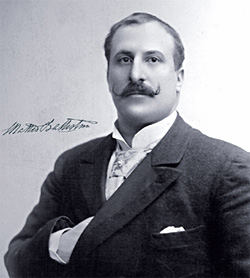The History of Mattia Battistini

Born: 27 February 1856
Died:7 November 1928
Italian Baritone
We begin with a question.
Suppose you were asked to fill a football stadium or the Albert Hall, for a charity opera recital, and you could select any male performer you chose. The only criteria being it was their obligation to ensure the largest turnout possible.
Who would you choose? Domingo, Pavarotti, Carreras?
Suppose you had to make this choice sometime before the First World War let’s say, 1913, but that unfortunately Caruso is not available.
Who would you choose?
If you had chosen, any of the wonderful tenors heard up until now, then you have failed in your obligation, because the most popular and famous male singers traveling around Europe and America, during the first 20 years of present century, were not tenors, (Caruso excepted of course), there were two baritones and a base.
Mattia Battistini, popularly dubbed the glory of Italy, traveled like a Prince wherever he went, and was treated as such.
I remember reading, that when he arrived at his hotel, always the best available, the porters had to unload 10 trunks of costumes that had been specially made for him, and he never traveled without them.
He was the great master of the Belcanto school, much like De Lucia and Bonci. His large legacy of records are among the most important documents of that vanished style.
Titto Ruffo was the other Baritone, almost an exact opposite of Battistini, with a voice that is great contemporary Guiseppe De Luca describes him, simply as ‘a miracle’.
He was a foremast exponent of the new Verismo operas, a sort of baritone Caruso and the very appearance of his name on a cast list, guaranteed a sell-out.
The base Russian Feodor Chaliapin, a trailblazer, setting new standards in the art of the singer actor and bringing Russian opera out of the confinement of its native country and into the international repertoire. An operatic giant and the first Russian singer to achieve worldwide recognition and acclaim.
I wonder if you were asked to pick a baritone or a base to fill your stadium today, if you could suggest the name of a suitable candidate.
Of course, these singers are interlopers into our present survey, but perhaps because of their unique position in popularity in their day, they might offer a special dispensation, just this once, and allow them one record each.
For Battisitini, I have chosen the 1921 version of Vien Leonora from La Favorita by Donizetti for two reasons, firstly it was in these belcanto roles that he was incomparable, and secondly because it tells us everything about his unique training and correct voice production, as believe it or not, he was 64 when this record was made.
Vien Leonara / Favorita /1921 – Mattia Battistini

The History as it was Recorded
Sydney Rhys Barker
